A
Auto Express
Guest
Mercedes-AMG has launched the new GT Black Series in the UK market priced from £335,000. It’s the most extreme road-going version of the car to date, drawing inspiration from the firm’s AMG GT GT3 race car and offering fresh competition for the Ferrari F8 Tributo.
The GT Black Series is powered by a heavily modified version of the standard car’s twin-turbocharged 4.0-litre V8 engine, which has been fitted with a host of go-faster bits pinched from Mercedes’s GT GT3 racer.
Upgrades include a set of reprofiled camshafts, new exhaust manifolds, bigger turbos, larger intercoolers and an aggressive tune for the car’s ECU. The upgrade package is finished off with a larger-bore, thin-wall stainless steel exhaust system.
All these revisions mean the engine now produces 720bhp and 800Nm of torque – which is 250bhp and 200Nm more than the entry-level AMG GT. Power goes to the rear wheels via a beefed-up version of the car’s seven-speed automatic gearbox, which AMG says gives this latest Black Series model a 0–62mph time of 3.2 seconds and a top speed of 201mph.
New Mercedes-AMG GT Black Series: chassis and brakes
Mercedes-AMG says the GT Black Series’s new engine is the most powerful V8 unit that has ever fitted to one of its cars – so, to keep all that performance in check, the firm has given the GT’s chassis a thorough overhaul with tougher, yet lighter, components.
There’s a new coil-over suspension system, which features electronically controlled dampers and double wishbone arms front and rear. The car’s suspension geometry has also been tweaked, allowing the GT Black Series to run more negative camber on the front axle – which Mercedes-AMG says will deliver improved cornering performance.

image

image

image
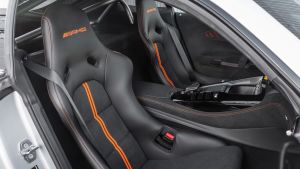
image

image

image

image

image

image

image

image

image
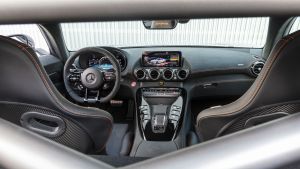
image

image

image
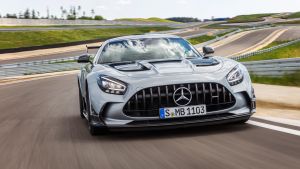
image

image

image

image

image

image
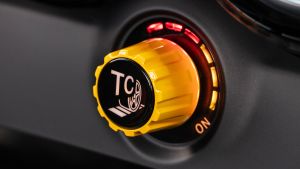
image

image

image
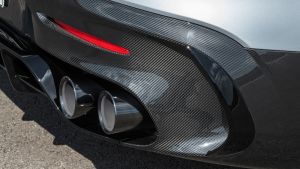
image

image

image
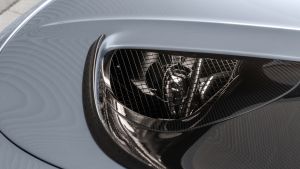
image

image
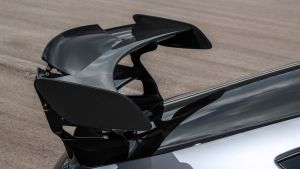
image

image

image

image

image

image

image

image

image

image
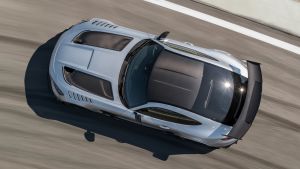
image

image

image

image

image
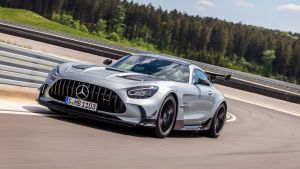
image

image

image

image
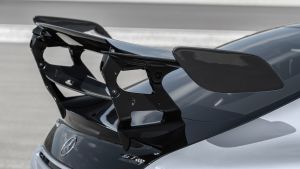
image

image

image

image

image

image
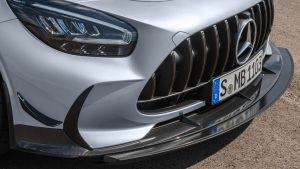
image
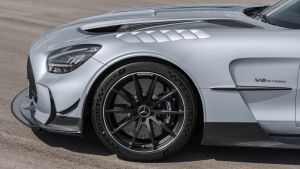
image

image
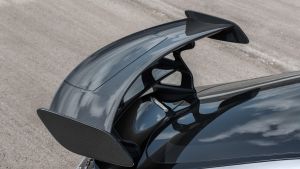
image

image
The GT Black Series also has a wider track than the standard model and, wherever possible, Mercedes has swapped metal components in the car’s chassis for carbon fibre replacement. So, there’s lightened versions of the GT’s front and rear torsion bars, as well as a new carbon fibre shear panel at the rear of the vehicle.
Mercedes has improved the GT’s brakes, too, with a larger set of drilled and vented ceramic discs with six-piston calipers up front and four-piston calipers at the rear – both of which are finished in black.
Finally, to take advantage of the upgraded chassis, the GT Black Series receives a set of wider, staggered alloy wheels wrapped in Michelin Pilot Sport Cup 2 tyres, as well as a new configurable traction control system which features the same nine-stage slip control settings as the firm’s GT3 racer.
New Mercedes-AMG GT Black Series: styling and aero
The AMG GT’s aerodynamics have been given an equally extensive update, with a similar range of tweaks as the firm’s GT3 racecar. Up front, there’s a new braced front splitter and reprofiled front bumper, which works with the new vented bonnet to improve the car’s downforce and expel excess heat from the engine bay.
Further upgrades include new vents for the front and rear wheel arches, allowing turbulent air which would normally be trapped in the wheel arches to escape. At the rear, there’s an aggressive diffuser and an enormous, manually adjustable rear wing, which can be tweaked through 20 degrees, offering either increased downforce or a reduced drag.
There’s also a new, near-full-length undertray, which the firm says will channel air towards the rear diffuser. In total, Mercedes-AMG says its aero tweaks produce a maximum of 400kg of downforce.
Finally, to lower the GT Black Series’s kerb weight and improve its centre of gravity, Mercedes-AMG has fitted a new carbon fibre roof, a carbon fibre boot lid and thinner glazing. The car’s hub carriers are also made from aluminium and there’s a new carbon fibre torque tube connecting the engine and the rear-mounted transmission.
New Mercedes-AMG GT Black Series: interior
The AMG GT Black Series’s interior is broadly similar to the standard car’s, sharing the same 12.3-inch digital instrument binnacle and 10.25-inch infotainment system – albeit with some specific graphics. There’s also a new microfibre-trimmed steering wheel, new stainless steel door cards and a pair of unique sport seats.
The most significant upgrade over the original GT is Mercedes-AMG’s Track Package, which adds a pair of carbon-fibre backed bucket seats, four-point safety harnesses, a 2kg fire extinguisher and a titanium roll-cage. However, buyers can swap the bucket seats for more accomodating, electrically operated and heated recliners as a no-cost option.
Buyers also have their choice of two upholstery finishes – both of which feature the “AMG Black Series” logo embroidered into the seat backrests. As standard, the Black Series’s cabin is trimmed in a blend of black synthetic leather and suede, with orange contrasting stitching. However, this can be swapped for black leather and grey stitching free of charge.
As is traditional with Mercedes’s Black Series models, this highly-tuned AMG GT will likely mark the end of the coupe’s lifespan. We expect it will remain in production until 2022 before being replaced by an-all new model.
Check out our list of the most retro cars below...

Mercedes’ modern recreation of its classic 300SL Gullwing from the 1950s, the SLS AMG mixed old-school muscle with advanced tech and cool retro lines.
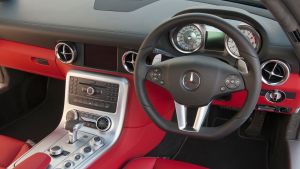
image

The current car has moved further away from the ethos of the original but the Mini DNA is still plain to see.

The retro lines now make it one of the most fashionable luxury 4x4s on the market.

image
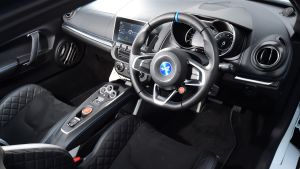
The retro shapes with modern lightweight technology have made it a highly capable and desirable sports car.
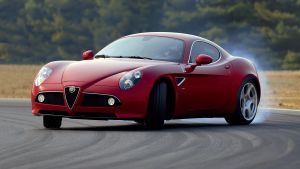
The beautiful arching lines of the Alfa Romeo 8C Competizione hark back to the brand’s golden age and made it the antithesis of contemporary supercars, with their aggressively aerodynamic bodies, when it launched in 2007.
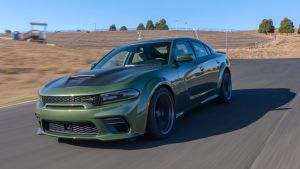
The Dodge Charger arrived in 1966 and while the seventh generation car launched in 2011 has less of an obvious retro design link to the early models than the Camaro or Mustang, it certainly carries their muscle car ethos - particularly in SRT-8 form.

The 7 isn’t so much retro as old. It’s been in production in one form or another since 1957 and retains a hyper-loyal following today partly because of its old-school charm. The basic, lightweight formula makes the Caterham Seven supremely capable too.

The concept behind the Mazda MX-5 Roadster is very much derived from the classic British sports cars of the 50’s and 60’s. It used to share design influences with them too but the latest models have ditched the retro for a more modern look.

image

Porsche has kept the 911’s styling consistent since the 1960s but the technology beneath the retro lines has evolved quickly keeping the coupe at the top of the sports car class.

Another one of the most famous names in motoring, the Ford Mustang helped define the muscle car era and is still going strong today.
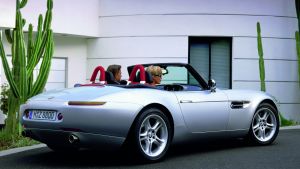
It was good enough for James Bond in The World Is Not Enough and what better endorsement could there be?
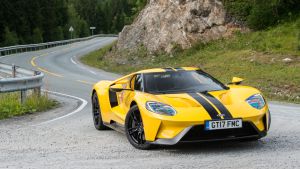
Ford chose to celebrate its most iconic racing car in 2005. The GT40 won Le Mans four times in a row between 1966 and 1969 and the new Ford GTs became upsized recreations of the original.

The retro themes returned to the Chevrolet Camaro family tree with the fifth generation model launched in 2010 and the Mk6 car built on that.
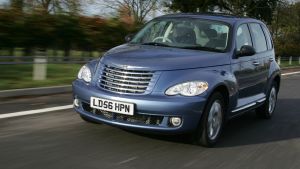
Launched in 2000, the PT Cruiser with its 1950s hot rod styling was a relative hit for Chrysler. It was roomy but dated underpinnings meant the car was off the pace by most other objective measures and the less said about the convertible, the better.

image
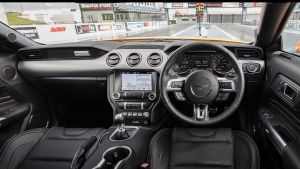
The latest model blends classic Mustang design themes with modern tech but a big V8 is still on the menu.

The classic roadster layout and curvy lines were pulled straight from the 50s while power came from the 4.9-litre V8 employed in the M5 saloon at the time.

image

Mercedes created a monster when it designed the G-Class back in the 1970s but the original tough offroader has been successfully gentrified in the years since.

image

BMW’s remake of the classic Mini has shown the rewards available if manufacturers can mine the retro seam skillfully enough.

The Land Rover Defender and the series Land Rover models before it have been a fixture in the British countryside for decades.
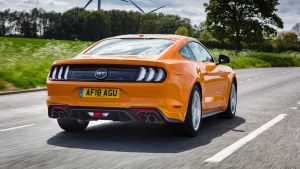
image
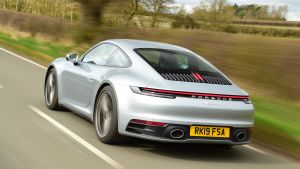
image

image

The new Alpine A110 launched in 2017 with a shape and philosophy that look back to the A110 of the 1960s.
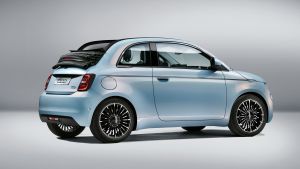
What is new is the pure-electric powertrain under those familiar lines.

The cute, retro styling hides an advanced EV powertrain and a high-tech interior based around a full-width touchscreen display.
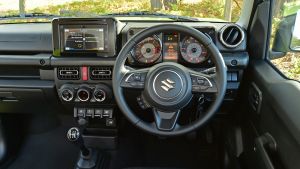
image

The 1991 Nissan Figaro paired the basic platform from a 1st generation Nissan Micra with a tiny sports car body that could have arrived from the 1960s by Tardis. It was never sold officially in the UK and is exclusively right-hand drive.

Suzuki’s Jimny is having a renaissance in fourth generation guise with the little SUV returning to its roots via a boxy, retro look that has propelled it into the thinking of trendy urban buyers.

The new Defender represents the biggest design overhaul the model has ever had but the jump in comfort and technology didn’t come at the expense of those familiar Defender design themes.
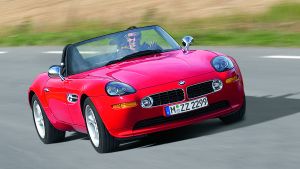
BMW paid tribute to the 507 of 1956 by launching the Z8 in 2000.

The Fiat 500’s cute retro looks have been seducing buyers since the mk2 version was launched in 2007.

Honda went right back to the original Civic hatchback of the 1970s for inspiration when designing the Honda e electric car.

image

Now it’s the mk3’s turn and Fiat had no intention of changing a winning design formula too much.

The ‘New’ Beetle arrived a few years before BMW’s remake of the MINI targeting the same kind of fashionable small car buyers, but would ultimately come off second best. The 1998 model based on the Mk4 Golf was updated by a better mk2 version in 2011.

image
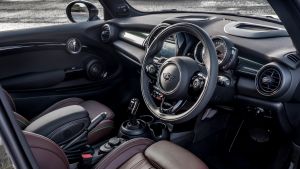
The new MINI actually followed hot on the heels of the old one, installing modern technology and more usable space beneath the classic retro lines.
Continue reading...
The GT Black Series is powered by a heavily modified version of the standard car’s twin-turbocharged 4.0-litre V8 engine, which has been fitted with a host of go-faster bits pinched from Mercedes’s GT GT3 racer.
- SEE MORE Best supercars 2020
Upgrades include a set of reprofiled camshafts, new exhaust manifolds, bigger turbos, larger intercoolers and an aggressive tune for the car’s ECU. The upgrade package is finished off with a larger-bore, thin-wall stainless steel exhaust system.
All these revisions mean the engine now produces 720bhp and 800Nm of torque – which is 250bhp and 200Nm more than the entry-level AMG GT. Power goes to the rear wheels via a beefed-up version of the car’s seven-speed automatic gearbox, which AMG says gives this latest Black Series model a 0–62mph time of 3.2 seconds and a top speed of 201mph.
New Mercedes-AMG GT Black Series: chassis and brakes
Mercedes-AMG says the GT Black Series’s new engine is the most powerful V8 unit that has ever fitted to one of its cars – so, to keep all that performance in check, the firm has given the GT’s chassis a thorough overhaul with tougher, yet lighter, components.
There’s a new coil-over suspension system, which features electronically controlled dampers and double wishbone arms front and rear. The car’s suspension geometry has also been tweaked, allowing the GT Black Series to run more negative camber on the front axle – which Mercedes-AMG says will deliver improved cornering performance.

image

image

image

image

image

image

image

image

image

image

image

image

image

image

image

image

image

image

image

image

image

image

image

image

image

image

image

image

image

image

image

image

image

image

image

image

image

image

image

image

image

image

image

image

image

image

image

image

image

image

image

image

image

image

image

image

image

image

image
The GT Black Series also has a wider track than the standard model and, wherever possible, Mercedes has swapped metal components in the car’s chassis for carbon fibre replacement. So, there’s lightened versions of the GT’s front and rear torsion bars, as well as a new carbon fibre shear panel at the rear of the vehicle.
Mercedes has improved the GT’s brakes, too, with a larger set of drilled and vented ceramic discs with six-piston calipers up front and four-piston calipers at the rear – both of which are finished in black.
Finally, to take advantage of the upgraded chassis, the GT Black Series receives a set of wider, staggered alloy wheels wrapped in Michelin Pilot Sport Cup 2 tyres, as well as a new configurable traction control system which features the same nine-stage slip control settings as the firm’s GT3 racer.
New Mercedes-AMG GT Black Series: styling and aero
The AMG GT’s aerodynamics have been given an equally extensive update, with a similar range of tweaks as the firm’s GT3 racecar. Up front, there’s a new braced front splitter and reprofiled front bumper, which works with the new vented bonnet to improve the car’s downforce and expel excess heat from the engine bay.
Further upgrades include new vents for the front and rear wheel arches, allowing turbulent air which would normally be trapped in the wheel arches to escape. At the rear, there’s an aggressive diffuser and an enormous, manually adjustable rear wing, which can be tweaked through 20 degrees, offering either increased downforce or a reduced drag.
There’s also a new, near-full-length undertray, which the firm says will channel air towards the rear diffuser. In total, Mercedes-AMG says its aero tweaks produce a maximum of 400kg of downforce.
Finally, to lower the GT Black Series’s kerb weight and improve its centre of gravity, Mercedes-AMG has fitted a new carbon fibre roof, a carbon fibre boot lid and thinner glazing. The car’s hub carriers are also made from aluminium and there’s a new carbon fibre torque tube connecting the engine and the rear-mounted transmission.
New Mercedes-AMG GT Black Series: interior
The AMG GT Black Series’s interior is broadly similar to the standard car’s, sharing the same 12.3-inch digital instrument binnacle and 10.25-inch infotainment system – albeit with some specific graphics. There’s also a new microfibre-trimmed steering wheel, new stainless steel door cards and a pair of unique sport seats.
The most significant upgrade over the original GT is Mercedes-AMG’s Track Package, which adds a pair of carbon-fibre backed bucket seats, four-point safety harnesses, a 2kg fire extinguisher and a titanium roll-cage. However, buyers can swap the bucket seats for more accomodating, electrically operated and heated recliners as a no-cost option.
Buyers also have their choice of two upholstery finishes – both of which feature the “AMG Black Series” logo embroidered into the seat backrests. As standard, the Black Series’s cabin is trimmed in a blend of black synthetic leather and suede, with orange contrasting stitching. However, this can be swapped for black leather and grey stitching free of charge.
As is traditional with Mercedes’s Black Series models, this highly-tuned AMG GT will likely mark the end of the coupe’s lifespan. We expect it will remain in production until 2022 before being replaced by an-all new model.
Check out our list of the most retro cars below...

Mercedes’ modern recreation of its classic 300SL Gullwing from the 1950s, the SLS AMG mixed old-school muscle with advanced tech and cool retro lines.

image

The current car has moved further away from the ethos of the original but the Mini DNA is still plain to see.

The retro lines now make it one of the most fashionable luxury 4x4s on the market.

image

The retro shapes with modern lightweight technology have made it a highly capable and desirable sports car.

The beautiful arching lines of the Alfa Romeo 8C Competizione hark back to the brand’s golden age and made it the antithesis of contemporary supercars, with their aggressively aerodynamic bodies, when it launched in 2007.

The Dodge Charger arrived in 1966 and while the seventh generation car launched in 2011 has less of an obvious retro design link to the early models than the Camaro or Mustang, it certainly carries their muscle car ethos - particularly in SRT-8 form.

The 7 isn’t so much retro as old. It’s been in production in one form or another since 1957 and retains a hyper-loyal following today partly because of its old-school charm. The basic, lightweight formula makes the Caterham Seven supremely capable too.

The concept behind the Mazda MX-5 Roadster is very much derived from the classic British sports cars of the 50’s and 60’s. It used to share design influences with them too but the latest models have ditched the retro for a more modern look.

image

Porsche has kept the 911’s styling consistent since the 1960s but the technology beneath the retro lines has evolved quickly keeping the coupe at the top of the sports car class.

Another one of the most famous names in motoring, the Ford Mustang helped define the muscle car era and is still going strong today.

It was good enough for James Bond in The World Is Not Enough and what better endorsement could there be?

Ford chose to celebrate its most iconic racing car in 2005. The GT40 won Le Mans four times in a row between 1966 and 1969 and the new Ford GTs became upsized recreations of the original.

The retro themes returned to the Chevrolet Camaro family tree with the fifth generation model launched in 2010 and the Mk6 car built on that.

Launched in 2000, the PT Cruiser with its 1950s hot rod styling was a relative hit for Chrysler. It was roomy but dated underpinnings meant the car was off the pace by most other objective measures and the less said about the convertible, the better.

image

The latest model blends classic Mustang design themes with modern tech but a big V8 is still on the menu.

The classic roadster layout and curvy lines were pulled straight from the 50s while power came from the 4.9-litre V8 employed in the M5 saloon at the time.

image

Mercedes created a monster when it designed the G-Class back in the 1970s but the original tough offroader has been successfully gentrified in the years since.

image

BMW’s remake of the classic Mini has shown the rewards available if manufacturers can mine the retro seam skillfully enough.

The Land Rover Defender and the series Land Rover models before it have been a fixture in the British countryside for decades.

image

image

image

The new Alpine A110 launched in 2017 with a shape and philosophy that look back to the A110 of the 1960s.

What is new is the pure-electric powertrain under those familiar lines.

The cute, retro styling hides an advanced EV powertrain and a high-tech interior based around a full-width touchscreen display.

image

The 1991 Nissan Figaro paired the basic platform from a 1st generation Nissan Micra with a tiny sports car body that could have arrived from the 1960s by Tardis. It was never sold officially in the UK and is exclusively right-hand drive.

Suzuki’s Jimny is having a renaissance in fourth generation guise with the little SUV returning to its roots via a boxy, retro look that has propelled it into the thinking of trendy urban buyers.

The new Defender represents the biggest design overhaul the model has ever had but the jump in comfort and technology didn’t come at the expense of those familiar Defender design themes.

BMW paid tribute to the 507 of 1956 by launching the Z8 in 2000.

The Fiat 500’s cute retro looks have been seducing buyers since the mk2 version was launched in 2007.

Honda went right back to the original Civic hatchback of the 1970s for inspiration when designing the Honda e electric car.

image

Now it’s the mk3’s turn and Fiat had no intention of changing a winning design formula too much.

The ‘New’ Beetle arrived a few years before BMW’s remake of the MINI targeting the same kind of fashionable small car buyers, but would ultimately come off second best. The 1998 model based on the Mk4 Golf was updated by a better mk2 version in 2011.

image

The new MINI actually followed hot on the heels of the old one, installing modern technology and more usable space beneath the classic retro lines.
Continue reading...
